
As the state's primary energy policy and planning agency, the CEC updates these standards every three years to increase the energy efficiency of California’s buildings, and to lower their cost of operation. Energy efficiency also reduces emissions of greenhouse gases (GHGs) and other pollutants. Buildings are responsible for a quarter of the GHG emissions and nearly 70 percent of California’s electricity use.
“Most of us spend the vast majority of our time on this earth inside buildings. These spaces must provide the conditions for all Californians to strive and thrive; clean air to breathe; comfortable places to live, work and create; and resilience in the face of the accelerating impacts of climate change,” said Commissioner J. Andrew McAllister, who is lead commissioner for energy efficiency at the CEC. “The 2025 Energy Code extends California’s leadership in the creation of a built environment that embodies our innovation-based economy and expands use of the clean, cost-effective technologies upon which our sustainable future depends.”

The adopted 2025 update will be submitted to the California Building Standards Commission (CBSC), which is scheduled to consider it in December 2024. If approved by the CBSC, the new standards would go into effect on January 1, 2026, giving builders, contractors and other interested parties a year to gear up for the changes.
The 2025 Energy Code focuses on key areas:
Each code update guides the construction of buildings that can better withstand extreme weather associated with climate change, lower energy use and costs, and reduce climate and air pollution. The 2025 Energy Code is projected to save $4.8 billion in energy costs over its lifetime and reduce GHG by about 4 million metric tons, equivalent to the annual energy consumption of over half a million homes.

